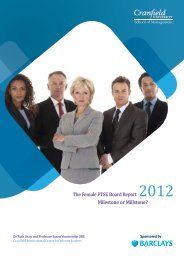Stakeholder Engagement - Cranfield School of Management ...
Stakeholder Engagement - Cranfield School of Management ...
Stakeholder Engagement - Cranfield School of Management ...
You also want an ePaper? Increase the reach of your titles
YUMPU automatically turns print PDFs into web optimized ePapers that Google loves.
How to Engage <strong>Stakeholder</strong>s<br />
‘<strong>Stakeholder</strong> engagement should be managed as one would manage any other business function.’ 14<br />
<strong>Engagement</strong> should be regarded as any other business project planning process, with adequate<br />
analysis, preparation, implementation, reporting, evaluation and follow up.The ideal stakeholder<br />
engagement process should be an iterative process, allowing engagement to benefit from diligent<br />
planning, thorough reporting and the application <strong>of</strong> learning as a result <strong>of</strong> appropriate evaluation<br />
and monitoring.<br />
<strong>Engagement</strong> with stakeholders has the possibility <strong>of</strong> securing a<br />
wide range <strong>of</strong> benefits for your organisation, from protecting the<br />
organisation’s licence to operate to gathering information on<br />
improved market or product performance. Done well, it can<br />
even lead to the development <strong>of</strong> new products and services.<br />
However, if an engagement process is poorly managed, it has the<br />
potential to undermine stakeholder relations resulting in mistrust<br />
and tension, as well as making the possibilities for future<br />
successful relations much more difficult.<br />
Box 4 lists some <strong>of</strong> the key basic characteristics to be considered<br />
in establishing an engagement process. Some present<br />
International Standards for <strong>Stakeholder</strong> <strong>Engagement</strong> with brief<br />
descriptions are listed in Appendix 5.1, for example AA1000 and<br />
the Global Reporting Initiative.<br />
Box 4: Basic Characteristics <strong>of</strong> <strong>Engagement</strong><br />
Ideally, an engagement process will be built on common values and vision.<br />
❖ Characterised as ‘two-way’ so that both sides have the opportunity to exchange views and information, to listen, and to<br />
have their issues addressed<br />
❖ Be free from manipulation or coercion<br />
❖ Be characterised by a long-term commitment from both sides<br />
❖ Involve a representative group <strong>of</strong> stakeholders<br />
❖ Be targeted at those most likely to be affected by the organisation<br />
❖ Be representative <strong>of</strong> your stakeholders, whether by gender, race, age, class, sexual orientation, education or religion<br />
❖ Not involve making commitments that cannot be delivered on<br />
Utilise best practice in engagement’s implementation.<br />
❖ Be developed early enough to scope key issues and have an effect on operational decisions<br />
❖ Be informed as a result <strong>of</strong> relevant information being disseminated in advance<br />
❖ Be meaningful to those consulted because the content is presented in a readily understandable format<br />
❖ Be relevant to the stakeholder and context you operate in, whether local or global<br />
❖ Put in place strong internal processes to build consensus and support among internal departments for stakeholder<br />
engagement and as a way to facilitate better engagement<br />
❖ Use techniques that are culturally appropriate<br />
❖ Use appropriate technology for the context, level <strong>of</strong> education or development <strong>of</strong> the stakeholders<br />
❖ Be designed to be context specific to reflect appropriate timeframes, local realities and languages<br />
❖ Utilise a documentation system to keep track <strong>of</strong> who has been consulted and key issues raised<br />
❖ Have a system for feeding back and following up on issues raised during consultation as well as clarification <strong>of</strong> next steps<br />
❖ Be managed by organisational staff who have facilitation, communication and conflict resolution skills<br />
❖ Have clear roles and scope about the objectives and activities to be achieved<br />
❖ Involve clarity <strong>of</strong> key point contacts on both sides<br />
Source: Adapted and expanded from material from Sequeira, Debra et al. 2007. <strong>Stakeholder</strong> <strong>Engagement</strong>: A Good Practice Handbook for<br />
Organisations Doing Business in Emerging Markets. International Finance Corporation; and, McCallum, Alison et al. 2007. SEAT: Socio-Economic<br />
Assessment Toolbox. Anglo American<br />
14 Grayson, David and Hodges, Adrian. 2004. Corporate Social Opportunity, 7 Steps to make Corporate Social Responsibility work for your Business. London:<br />
Greenleaf Publishing<br />
15<br />
3<br />
How to Engage <strong>Stakeholder</strong>s
















